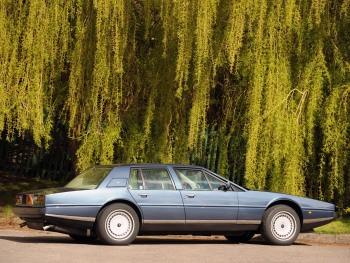HURRY JOB
William Towns designed this totally unique sedan in a much shorter period of time than the time it took to assemble the device somewhat decently: The Aston Martin Lagonda. As a rule, and certainly in this class, the opposite happened, and for good reason. Something's gotta give. And that also happened. In fact, he ultimately owed his bad image to it. But it wasn't there yet. On the drawing board everything was perfect and above all very state of the art on this freak Grand Tourer. Once built and sold, it turned out to be quite a few loose ends. Remarkably often in the wiring too.
SHORT-TERM IN THE IDEA BUS
The design was extreme on all fronts. In addition to its unparalleled appearance, technology was almost alien at the time. And not tested, irrevocably a guarantee for spectacle. The super sedan was a wedge-shaped box of ideas on wheels. That many of these different ideas were difficult to combine or rather faltered did not bother at all. Not in the design, at least. Everything worked and worked there. For example, the Aston Martin Lagonda was the absolute forerunner in the field of on-board computer management and the set of instruments was completely digital. But usually broken. The electronics of this very expensive Aston Martin Lagonda turned out to be an achilles heel and inadvertently became his pièce de résistance. On upper class birthdays it was only about smoke from the fuse box or horn-twisted digi-dashboards that suddenly received Botswana 3. Short circuit…
EXPENSIVE HOCUS POCUS
Touch keys, computers and digital instruments; it was all still hocus-pocus in those years. If it wasn't about the NASA and their space capsules, at least, and even those brilliant scientists found that all very complicated. That also made William's brainchild a technically daring design. And expensive. Very expensive. The development of the incomprehensibly complicated electronics and the dashboard exceeded the total budget for the Aston Martin Lagonda four times. , which was built entirely by hand in three months. Of course that was not possible for a joke and so was the Aston Martin Lagonda, in addition to being at the top of the breakdown statistics, also at the top of the price lists. A Rolls-Royce was cheaper, but also a lot more common. More for the upper plebs.
BUT ALSO CRAFT
Yet not everything was on the Aston Martin Lagonda from another planet. Under the endless engine hood lay a relatively simple eight-cylinder, actually nothing special. A little thirsty, though. Not surprisingly, of course, with a capacity of 5,4 liters you will not win any efficiency marathons. But this technique and most of his mechanics was straight forward and much less worrying than anything that had a wire or connector attached to it. The hand-built block delivered such an 285 hp to the rear wheels. With this, this spectacle part sprinted to 7 km / h within 100 seconds. Those were Ferrari-worthy times at the time. This is how Aston Martin saw the Lagonda: the performance of a Ferrari and the luxury and quality of a Rolls-Royce. Opinions differed over time on that last point, but the fact was that the Aston Martin Lagonda was built entirely by hand in the best British tradition. The bodywork was knocked by hand and formed from aluminum and also the engine was handmade by a craftsman, who then left a name tag on his masterpiece. It wasn't his fault.
UNIQUE LUXURY
The interior was also designed with love skilled craftsmen. Nine carefully selected skins were used in every interior, and if it wasn't made of leather, it was made of wood. As far as it was not about the upholstery, of course. Extravagant luxury such as a television or a built-in bar were also possible. And everything packaged in that completely unique and unparalleled bodywork that was just as low as a Porsche 911. A small 650 daring man with a cloth hooked their necks and bought a brand new Aston Martin Lagonda, which was built in four small series from 1976 to 1990. The successive series meant, in addition to a few technical adjustments such as fuel injection and far-reaching changes to the dashboard, mainly aesthetic adjustments; for example, the headlamps were replaced by six fixed ones and the characteristic angles were slightly less sharp in the last series. But it never got used to this day. Then you just buy a Rolls.







